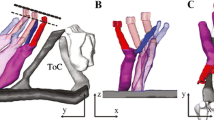Summary
Hair cells of the guinea-pig cochlea and vestibular system were prepared for electron-microscopic examination by fixing in glutaraldehyde without the use of osmium. An extensive array of cross-links was seen between the apical ends of the stereocilia, by both scanning and transmission electron microscopy. Some cross-links ran laterally between stereocilia of the same row. Others ran laterally between the stereocilia of the different rows, holding the tips of the shorter stereocilia in towards the longer stereocilia of the next row. In addition, each tip on the shorter stereocilia gave rise to a single, upwards pointing link, which ran upwards to join the adjacent taller stereocilium of the next row. We suggest that distortion of this link might be involved in the mechanics or even the membrane biophysics of sensory transduction.
With this method of preservation, all the apical surface membranes of the hair cells appeared rough, and contained dense granules. The roughness was greatest in the parts of the stereocilia to which the cross-links were attached. The mitochondrial and synaptic membranes of the hair cells appeared normal.
Similar content being viewed by others
References
Amako K, Umeda A (1977) Bacterial surfaces as revealed by high-resolution scanning electron microscope. J Gen Microbiol 98:297–299
Bagger-Sjöbäck D (1974) The sensory hairs and their attachments in the lizard basilar papilla. Brain Behav Evol 10:88–94
Bagger-Sjöbäck D, Flock A (1977) Freeze-fracturing of the auditory basilar papilla in the lizard Calotes versicolor. Cell Tissue Res 177:431–443
Bagger-Sjöbäck D, Wersäll J (1973) The sensory hairs and tectorial membrane of the basilar papilla in the lizard Calotes versicolor. J Neurocytol 2:329–350
Bredberg G, Ades HW, Engström H (1972) Scanning electron microscopy of the normal and pathologically altered organ of Corti. Acta Otolar Suppl 301:3–48
Flock A (1965) Transducing mechanisms in the lateral line canal organ receptors. Cold Spring Harbor Symp Quant Biol 30:133–145
Flock A (1977) Physiological properties of sensory hairs in the ear. In: Evans EF, Wilson JP (eds) Psychophysics and physiology of hearing. Academic Press, London, pp 15–25
Hama K, Saito K (1981) The fine structure of the sensory epithelium in the acoustico-lateralis system. Adv Neurol Sci 25:756–776
Hillman DE (1969) New ultrastructural findings regarding a vestibular ciliary apparatus and its possible functional significance. Brain Res 13:407–412
Hirokawa N, Tilney LG (1982) Interactions between actin filaments and between actin filaments and membranes in quickfrozen and deeply etched hair cells of the chick ear. J Cell Biol 95:249–261
Hudspeth AJ (1982) Extracellular current flow and the site of transduction by vertebrate hair cells. J Neurosci 2:1–10
Hudspeth AJ (1983) Mechanoelectrical transduction by hair cells in the acousticolateralis sensory system. Ann Rev Neurosci 6:187–215
Hudspeth AJ, Corey DP (1977) Sensitivity, polarity, and conductance change in the response of vertebrate hair cells to controlled mechanical stimuli. Proc Natl Acad Sci USA 74:2407–2411
Hudspeth AJ, Jacobs R (1979) Stereocilia mediate transduction in vertebrate hair cells. Proc Natl Acad Sci USA 76:1506–1509
Hunter-Duvar I (1977) Morphology of the normal and acoustically damaged cochlea. Scanning Electron Microsc 2:421–428
Jahnke K (1975) The fine structure of freeze-fractured intercellular junctions in the guinea pig inner ear. Acta Otolar Suppl 336:1–40
Kimura RS (1966) Hairs of the cochlear sensory cells and their attachment to the tectorial membrane. Acta Otolar 61:55–72
Lowenstein O, Wersäll J (1959) A functional interpretation of the electron-microscopic structure of sensory hairs in the cristae of the elasmobranch Raja clavata in terms of directional sensitivity. Nature 184:1807–1808
Macartney JC, Comis SD, Pickles JO (1980) Is myosin in the cochlea a basis for active motility?. Nature 288:491–492
Moran DT, Carter Rowley J, Asher DL (1981) Calcium-binding sites on sensory processes in vertebrate hair cells. Proc Natl Acad Sci USA 78:3954–3958
Oschman JL, Wall BJ (1972) Calcium binding to intestinal membranes. J Cell Biol 55:58–73
Sand O (1975) Effects of different ionic environments on the mechano-sensitivity of lateral line organs in the mudpuppy. J Comp Physiol Ser A 102:27–42
Sjöstrand FS, Barajas L (1968) Effects of modifications in conformation of protein molecules on structure of mitochondrial membranes. J Ultrastruct Res 25:121–155
Soudijn ER (1976) Scanning electron microscope study of the organ of Corti in normal and sound-damaged guinea pigs. Ann Otol Rhinol Laryngol Suppl 29 85:1–58
Tilney LG, DeRosier DJ, Mulroy MJ (1980) The organization of actin filaments in the stereocilia of cochlear hair cells. J Cell Biol 86:244–259
Author information
Authors and Affiliations
Rights and permissions
About this article
Cite this article
Osborne, M.P., Comis, S.D. & Pickles, J.O. Morphology and cross-linkage of stereocilia in the guinea-pig labyrinth examined without the use of osmium as a fixative. Cell Tissue Res. 237, 43–48 (1984). https://doi.org/10.1007/BF00229198
Accepted:
Issue Date:
DOI: https://doi.org/10.1007/BF00229198




